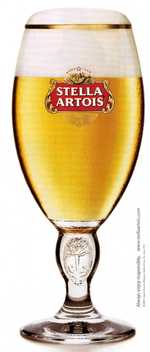Being different visually
The ability of a brand to stand out in the marketplace will enhance its chance of standing out in the mind. We live in an over-communicated world where each of us is bombarded with hundreds of branding, advertising and editorial messages daily. If your brand looks like every other brand, it isn’t likely to be noticed.
Looking the same as everybody else might be a good strategy if you are a 13 year-old-girl in middle school, but not if you are a brand looking to succeed in the marketplace.
A visual difference is important for three reasons:
1: Gets your brand noticed in a crowded marketplace.
2: Establishes your unique position.
3: Reminds customers of your brand every time they see your visual difference.
A unique visual difference is usually created by taking the standard look in a category and flipping it on its head.
Take beer, for example. Most beer is consumed in pint glasses, bottles or cans. All manly delivery vehicles. Not Stella Artois. Stella is served in a chalice glass, a delicate glass with a stem.
A Stella Artois glass looks more like a wine or an iced-tea glass than a beer glass. Of course, there are many technical and historic reasons for the glass. The chalice, along with a special Stella pouring ritual, allows the beer to flow, breathe and develop a proper head. According to its website: “Not only does the beer taste great, it also looks wonderful.”
Stella could have said: “Not only does the beer taste great, but it also looks different. And being different is what has built our brand in the mind.”
People see a Stella chalice and say “Wow! What is that you’re drinking?” The glass is not for everybody, of course. Building a powerful brand requires sacrifice. By giving up thebeer-guzzling frat boys and their bars, Stella Artois has been able to focus on the upscale market and force its glass into distribution.
At first, bars didn’t want to deal with the Stella glasses which are delicate, hard to wash and don’t stack like pint glasses. But Stella stuck to its guns and its chalices. And its dedication has paid off. (Nobody said executing a good strategy is easy.)
Many brands were built with a striking visual difference:
– Lime in the top of a Corona bottle.
– Curves of a Coke bottle.
– Grille on a Mercedes.
– Grille on a BMW.
– Wristband of a Rolex.
– Thinness of a Razr.
– Small can of a Red Bull.
Many times a unique visual difference can be created with a color:
– Green jacket at the Master’s golf championship.
– Red hat of a cardinal.
– White ear buds of an iPod.
– Orange handle of a Fiskars scissors.
– Purple Nexium pill.
– Brown UPS truck.
– Red bull’s eye of a Target store.
– Gold jacket at Century 21.
Why has the Toyota Prius outsold the Honda Civic hybrid more than 3-to-1? Because the Prius looks different than any car on the road. (You can’t tell a regular Civic from a hybrid unless you bend down and search for the small wording on the back bumper.)
One automobile expert explained the success of the Prius over the Civic hybrid with the comment: “Consumers don’t want a hybrid. They just want a car that looks like a hybrid.”
Consumers buy hybrids, of course, because they want to do something positive about the environment. But they also want to make sure everybody else on the road knows they are doing something about the environment. The biggest mistake car makers make with hybrid technology is converting existing models into hybrids. They should be thinking new models and new names, if not totally new brands.
A visual difference also helps to establish a strong number-two brand. After Red Bull got going, hundreds of companies including Coca-Cola flooded the market with me-too energy-drink brands. All the me-too brands copied Red Bull and its small 8.3-oz. can. (Small is a good visual symbol for an energy drink because it connotes the stuff is strong. But Red Bull owns the “small can” visual.)
The way to build a strong number-two brand is to be different. That’s exactly what Monster did. It was first to introduce a 16-oz. can and a 16-oz. name.
Today, Monster is the number-two brand in the energy-drink category. After Monster’s success, everybody rushed to market with their own large cans, but it didn’t matter. The spoils go to the first brands in the mind and those brands are Red Bull and Monster.
Being different doesn’t work every time. The laws of marketing are not 100% guaranteed. There are always exceptions.
One exception is the Pontiac Aztek, a car that was certainly different but about as successful as the Edsel. There has to be a strategy behind a difference. Suburban Moms driving SUVs don’t want to be different. Their 13-year-old daughters would die from embarrassment.
On the other hand, young urban car customers love to be different, so the odd-shaped Scion, a youth-focused brand, is doing great.
Being different may seem risky and your distribution channels may scream, but it can be well worthwhile. Being different may kill you in middle school but not in the mind which is where powerful brands are built.
 ?>
?>


